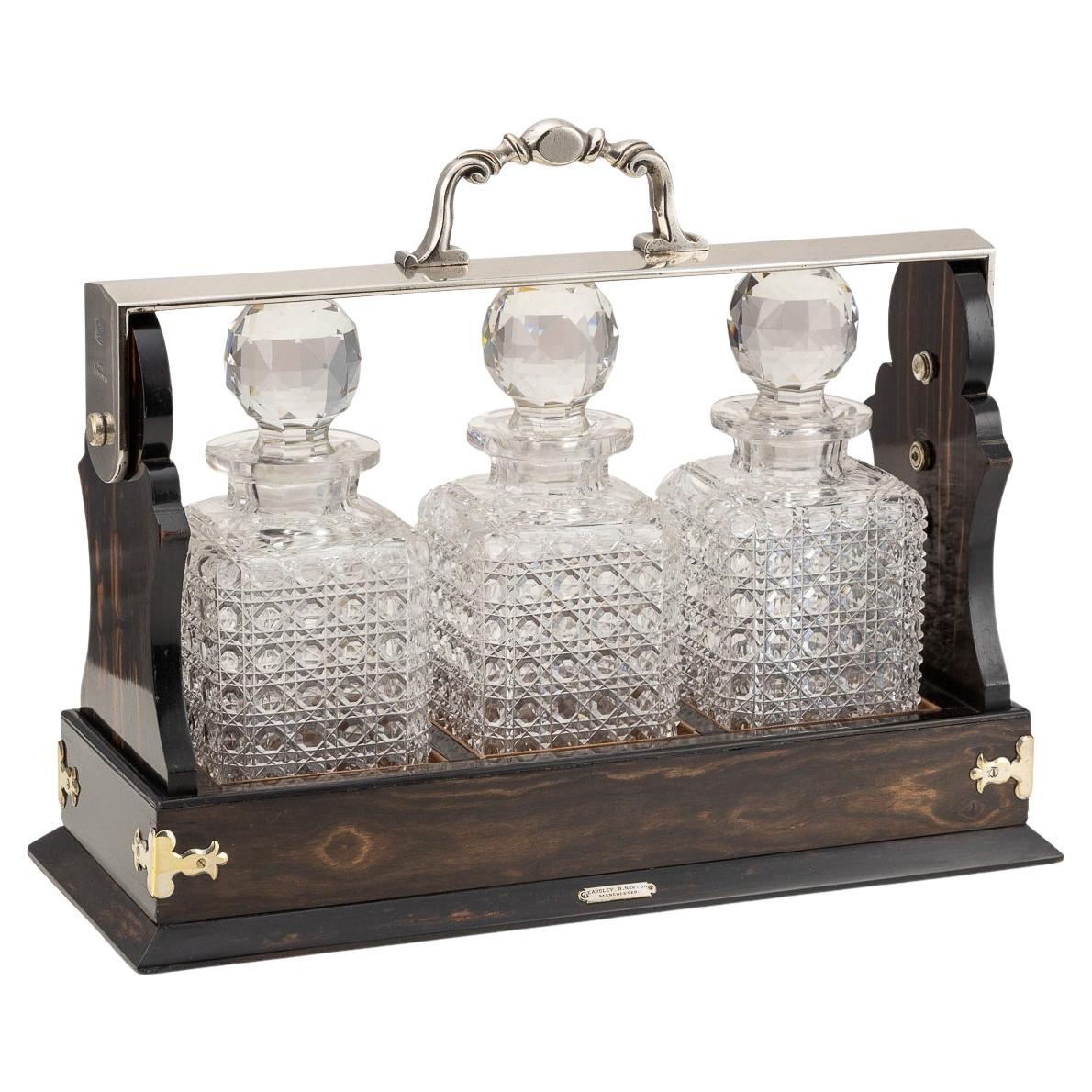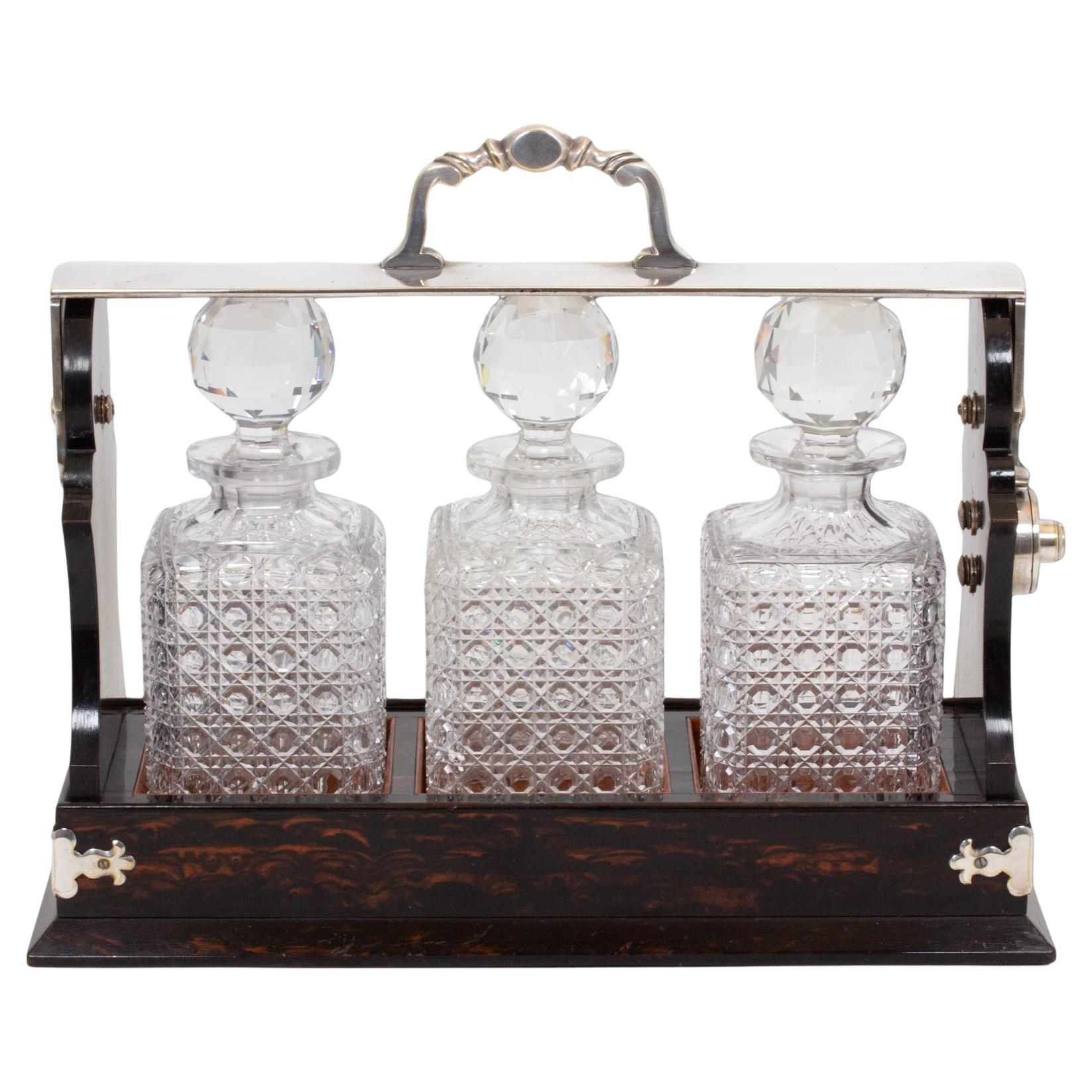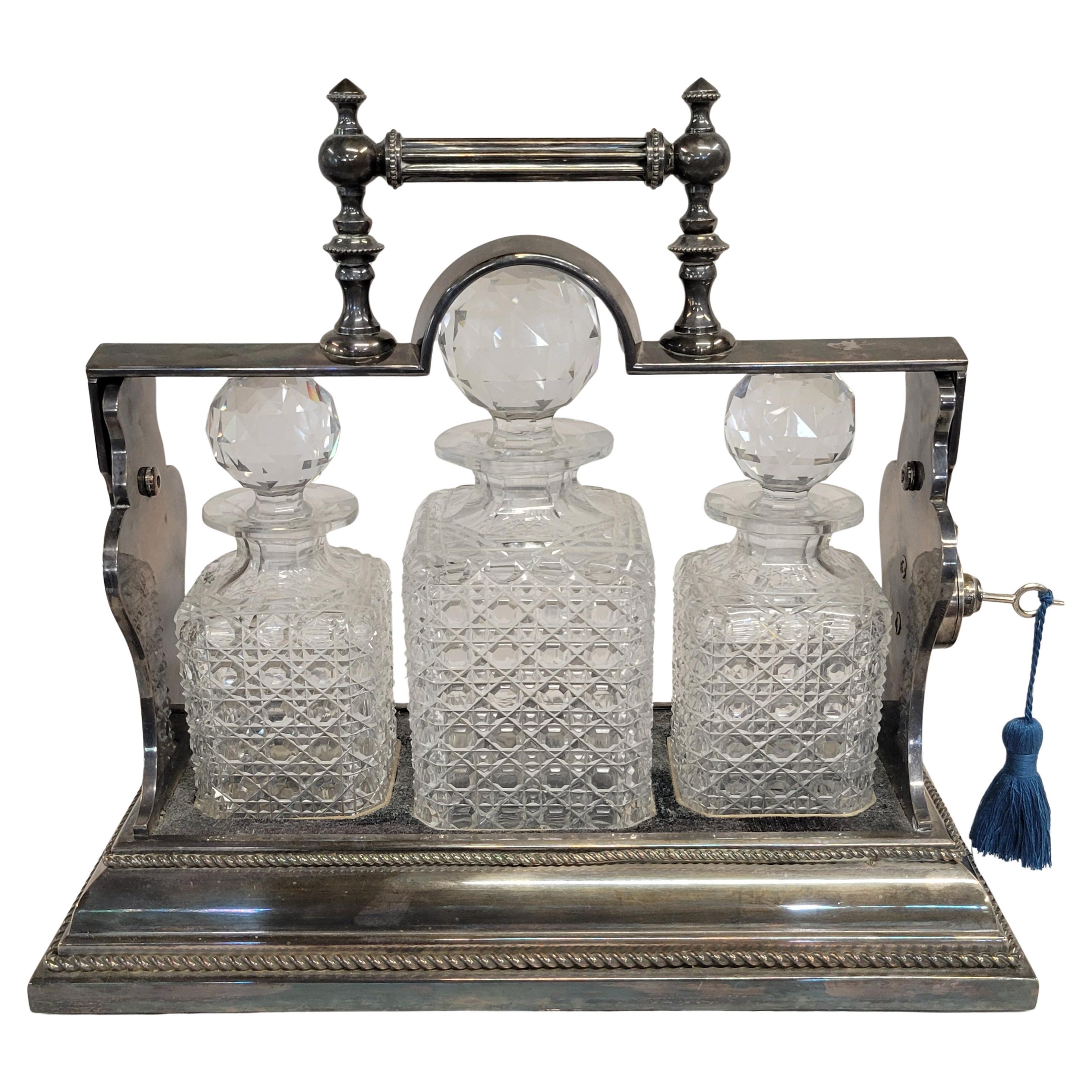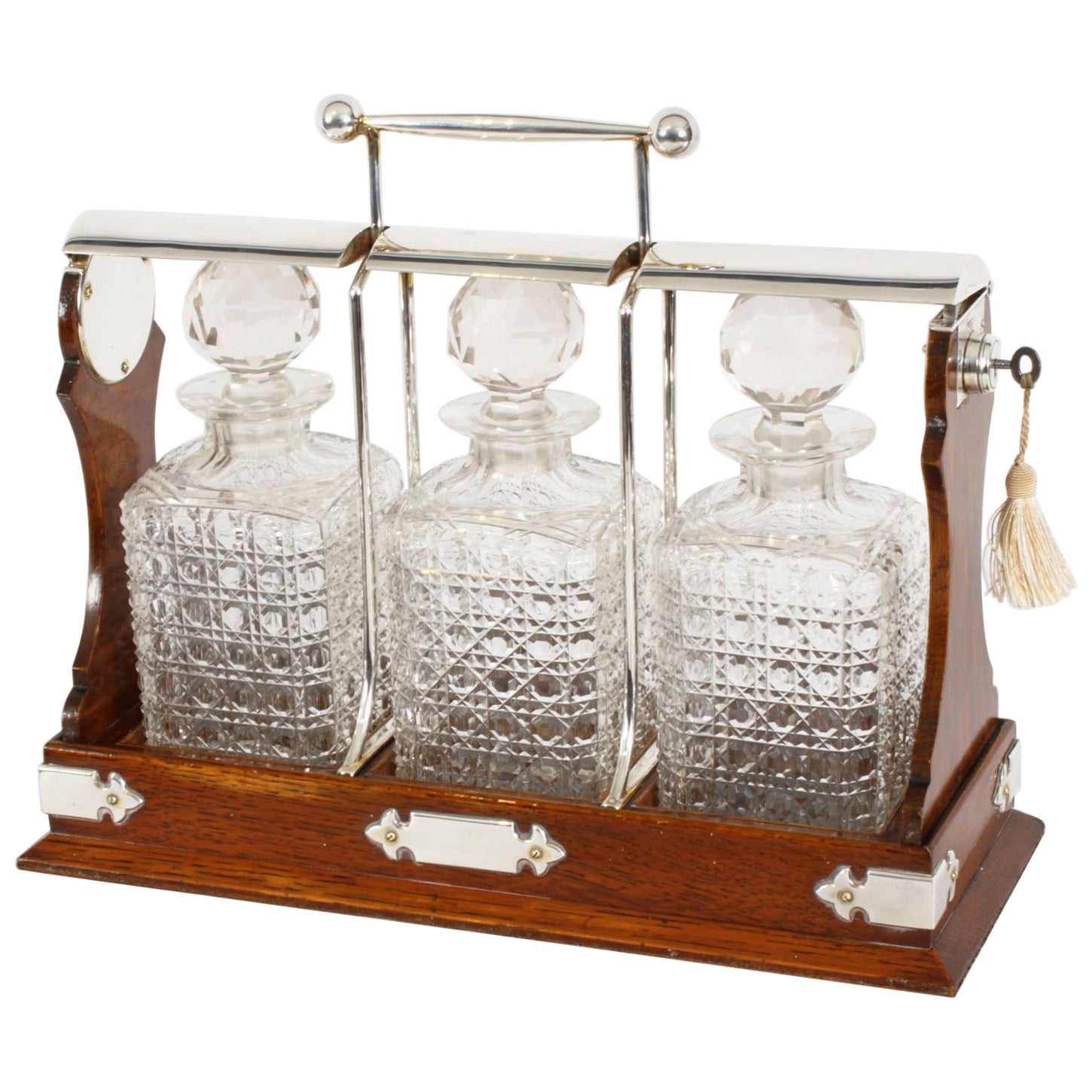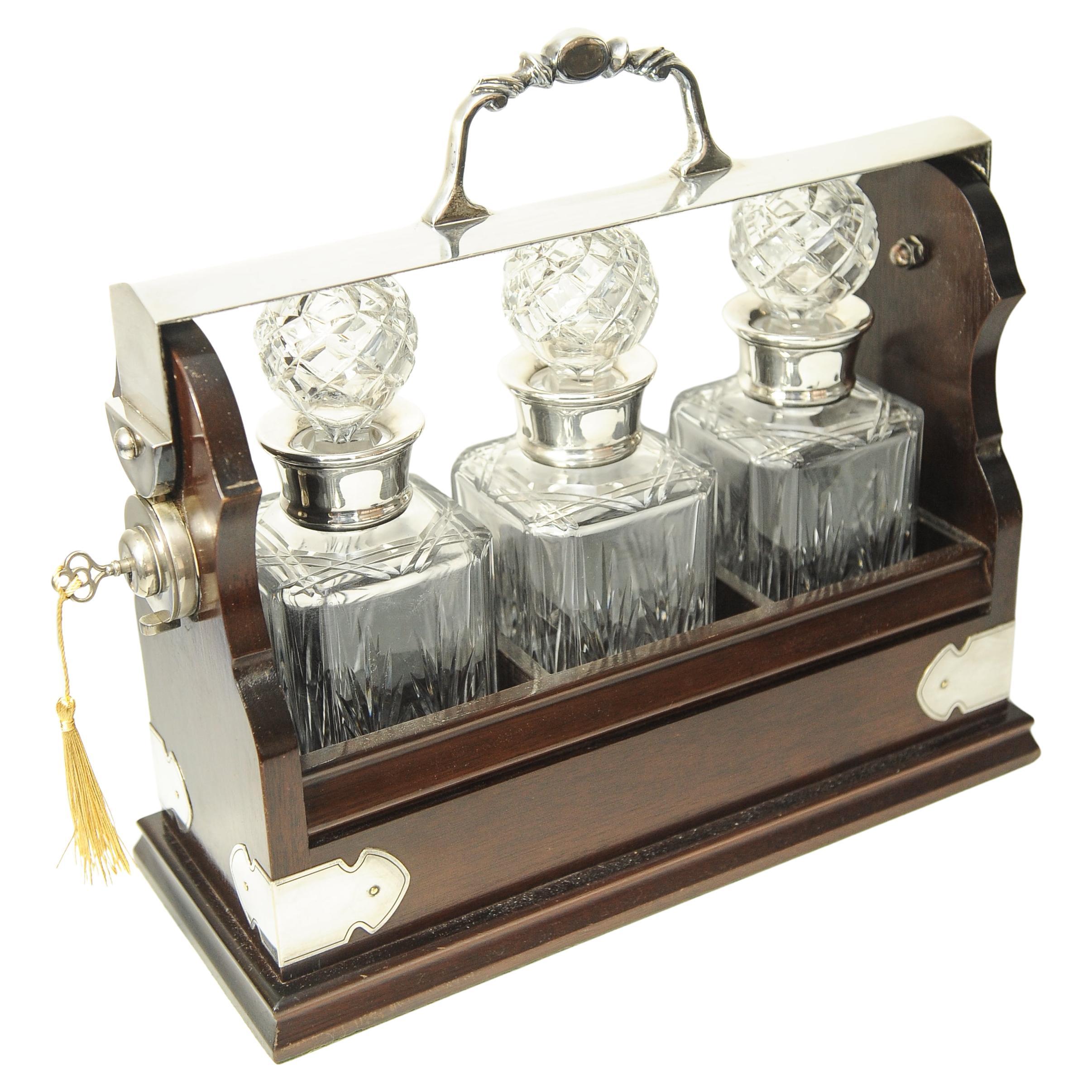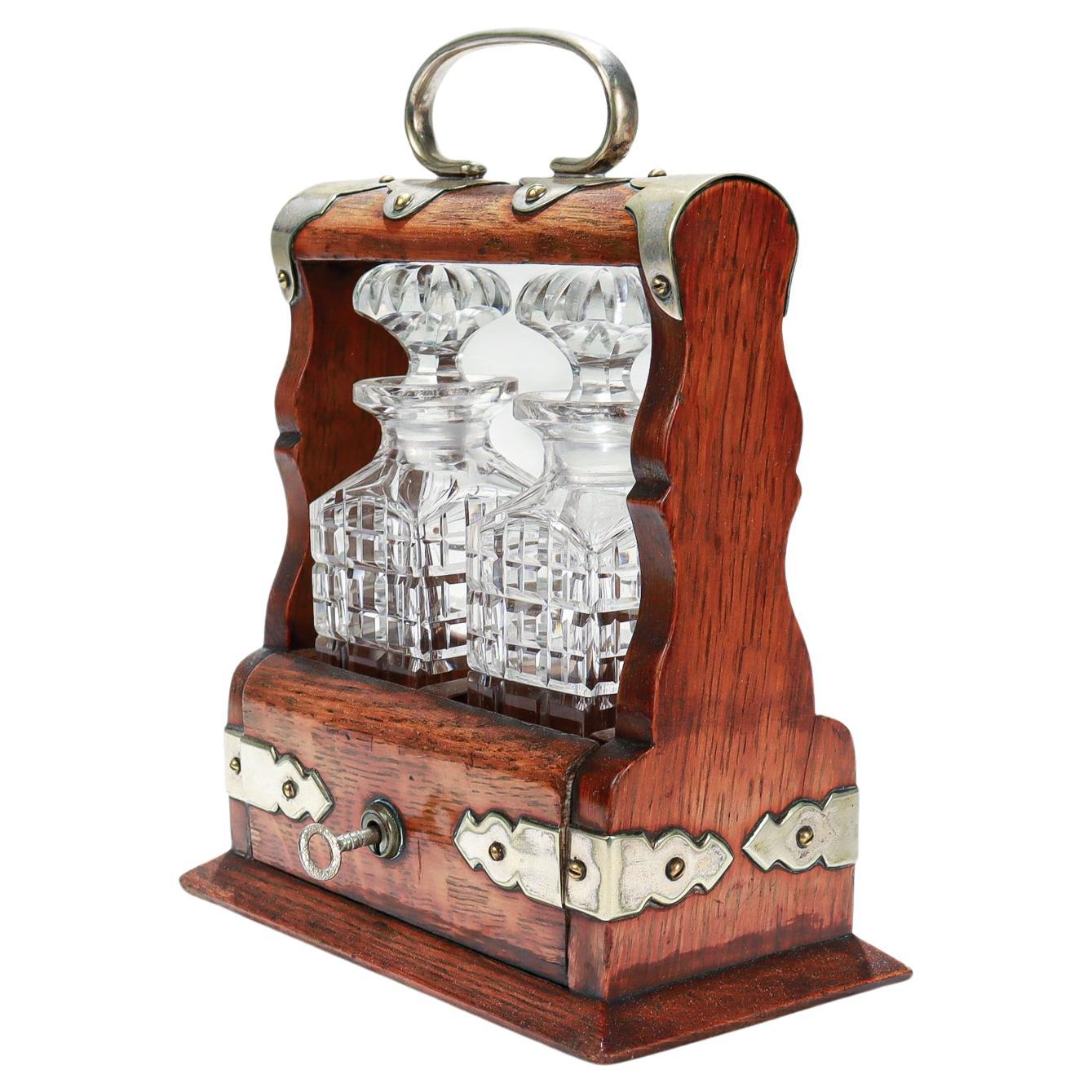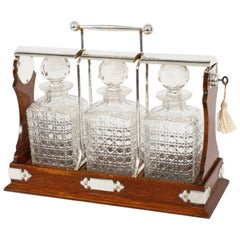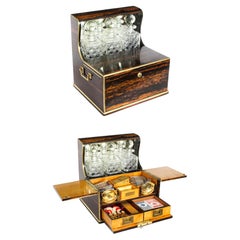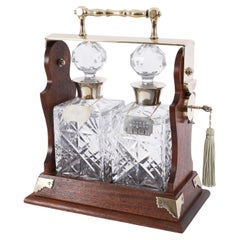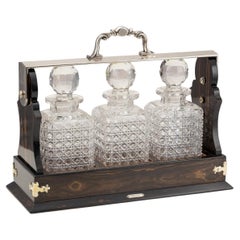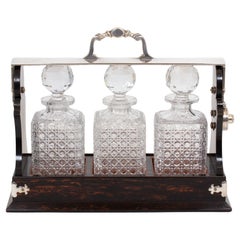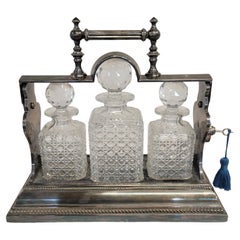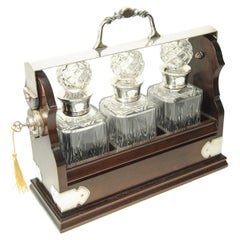Items Similar to Antique Betjemann’s Coromandel Miniature 3 Bottle Tantalus 19th Century
Video Loading
Want more images or videos?
Request additional images or videos from the seller
1 of 18
Antique Betjemann’s Coromandel Miniature 3 Bottle Tantalus 19th Century
$1,872.83per set
£1,375per set
€1,611.63per set
CA$2,621.06per set
A$2,873.79per set
CHF 1,500.67per set
MX$34,582.40per set
NOK 18,913.53per set
SEK 17,783.58per set
DKK 12,035.90per set
About the Item
This is a superb antique Victorian coromandel and silver plated three decanter Betjemann’s patent action tantalus, Circa 1870 in date.
The bottles each with hobnail cut decoration and bulbous stoppers, one with a sterling silver collar annotated for Whisky
Skillfully crafted in coromandel with a stylish silver plated locking bar, stamped one side ‘Betjemann's Patent, London, 10001, and a crown over "The Tantalus", on the other
It is fitted with a Betjemann’s Bramah locking system, complete with original key.
It is a very decorative high quality piece which is also very practical and would make a lovely gift.
Condition:
In excellent condition having been beautifully cleaned and wax polished in our workshops.
Dimensions in cm:
Height 18.5 cm x Width 23.5 cm x Depth 9.5 cm
Dimensions in inches:
Height 7 inches x Width 9 inches x Depth 4 inches
Betjemann & Sons
In 1812 George Betjemann started apprenticing as a cabinet maker with his uncle, Gilbert Slater at his premises on Carthusian Street, London. In 1834, George then joined his father-in-law, William Merrick’s cabinet making business on Red Lion Street, Clerkenwell, London. George brought his sons, George William Betjemann and John Betjemann to apprentice with him from 1848. He began his own business at 6 Upper Ashby Street, Clerkenwell, London, and with his two sons having completed their apprenticeships in 1855, expanded to 7 Upper Ashby Street shortly after.
In 1859, George moved into 36 Pentonville Road, London where he continued his business, now called George Betjemann & Sons, alongside his two sons. George William never married but instead was ‘married’ to his work, being a true artist and perfectionist. Their work was on display at the International Exhibition of 1862, and the International Exposition of 1867 in Paris. They took the art of cabinet, box and book slide making to new heights. They specialised in designs for operating the way that different compartments in vanity boxes opened and also the sprung system for book slides.
By 1871, they had expanded their residence to incorporate 38 Pentonville Road and were employing 119 people. Records show that by 1875 a further incorporation of 40 Pentonville Road was undertaken. George died in 1886 at the age of 88 and George William and John ran George Betjemann & Sons in partnership until John’s death in 1893. George William then established a business partnership with John’s sons, John George Betjemann and Ernest Edward Betjemann. Around 1896, John George and Ernest Edward established an offshoot company called Betjemann Brothers, based at 2 Newcastle Place, Clerkenwell, London. This company ran alongside George Betjemann & Sons until they were merged in 1903, following the death of George William. In 1909, they became a limited company, known as George Betjemann & Sons Ltd.
With Ernest’s son John (the future poet Sir John Betjeman) having no interest in carrying on the family business, George Betjemann & Sons Ltd finally wound up in 1939.
Bramah
is London's oldest security company. Established at 124 Piccadilly, London in 1784, and today based in Marylebone, London and Romford, Essex.
Bramah made their first lock in 1784 and the patent was awarded in 1787. The designer was Joseph Bramah. Joseph Bramah was a leading inventor of the industrial revolution, patenting over 18 new ideas, including a new valve for the water closet (toilet), the hydraulic pump, a fountain pen, and a fire engine.
Bramah also introduced a beer hand pump for use at the bar, to prevent fluid loss when barmen went downstairs to pour a new jug! Due to the quality of his manufacturing, his name became a by-word amongst British Engineers for engineering excellence and many of his inventions are on display in the Science Museum in London. You can find one of his original toilets still working in Osborne House, Queen Victoria's home on the Isle of Wight.
The Bramah lock was unique and advanced property and valuables protection enormously. Indeed it was 50 years ahead of any Chubb lock and 70 years ahead of Yale. Original Bramah locks are most often found on the highest quality homes and furniture.
Coromandel wood or Calamander wood
is a valuable wood from India, Sri Lanka and South East Asia. It is of a hazel-brown color, with black stripes (or the other way about), very heavy and hard. It is also known as Macassar Ebony or variegated ebony and is closely related to genuine ebony, but is obtained from different species in the same genus; one of these is Diospyros quaesita Thwaites, from Sri Lanka. The name Calamander comes from the local sinhalese name, 'kalu-medhiriya', which means dark chamber; referring to the characteristic ebony black wood.
Coromandel wood has been logged to extinction over the last 2 to 3 hundred years and is no longer available for new work in any quantity. Furniture in coromandel is so expensive and so well looked after that even recycling it is an unlikely source. A substitute, Macassar Ebony, has similar characteristics and to the untrained eye is nearly the same but it lacks the depth of colour seen in genuine Coromandel.
Our reference: A4259
- Creator:George Betjemann & Sons (Manufacturer)
- Dimensions:Height: 7.29 in (18.5 cm)Width: 9.26 in (23.5 cm)Depth: 3.75 in (9.5 cm)
- Sold As:Set of 4
- Style:Victorian (In the Style Of)
- Materials and Techniques:
- Place of Origin:
- Period:
- Date of Manufacture:circa 1870
- Condition:
- Seller Location:London, GB
- Reference Number:Seller: A42591stDibs: LU950643236532
About the Seller
5.0
Platinum Seller
Premium sellers with a 4.7+ rating and 24-hour response times
Established in 1983
1stDibs seller since 2012
1,406 sales on 1stDibs
Typical response time: <1 hour
Associations
LAPADA - The Association of Arts & Antiques Dealers
- ShippingRetrieving quote...Shipping from: London, United Kingdom
- Return Policy
Authenticity Guarantee
In the unlikely event there’s an issue with an item’s authenticity, contact us within 1 year for a full refund. DetailsMoney-Back Guarantee
If your item is not as described, is damaged in transit, or does not arrive, contact us within 7 days for a full refund. Details24-Hour Cancellation
You have a 24-hour grace period in which to reconsider your purchase, with no questions asked.Vetted Professional Sellers
Our world-class sellers must adhere to strict standards for service and quality, maintaining the integrity of our listings.Price-Match Guarantee
If you find that a seller listed the same item for a lower price elsewhere, we’ll match it.Trusted Global Delivery
Our best-in-class carrier network provides specialized shipping options worldwide, including custom delivery.More From This Seller
View AllAntique Victorian Silver Plated 3 Bottle Tantalus by Hobbs & Co 19th Century
Located in London, GB
An attractive Victorian English silver plate mounted oak three bottle tantalus set by Hobbs & Co circa 1870 in date.
It features a unique 'Hold Fast' patented locking mechanism that slides across to release the decanters, complete with the original key, with three hand cut crystal decanters...
Category
Antique 1870s English Victorian Sheffield and Silverplate
Materials
Silver
Antique Inlaid Walnut Three Cut Crystal Decanter Tantalus C1870 19th Century
Located in London, GB
This is a superb antique Victorian walnut cased three decanter tantalus with decorative inlaid satinwood decoration, c1870 in date.
It was skillfully crafted in walnut with beautifu...
Category
Antique 1870s English Victorian Platters and Serveware
Materials
Walnut
Antique Victoran Coromandel Three Crystal Decanter Tantalus & Games 19th Century
Located in London, GB
This is a superb antique Victorian coromandel, ormolu mounted and cased three decanter tantalus and games compendium, circa 1870 in date.
It was skilfully crafted in rare coromandel with a satinwood interior and ormolu mounts. The three cut crystal glass decanters with stoppers, a mirrored back and compartmens containing four cut glass drinking glasses...
Category
Antique 1870s Victorian Crystal Serveware
Materials
Crystal, Ormolu
Vintage Victorian Silver Plated Tantalus SJ Rose & Son 20th Century
Located in London, GB
A beautiful Victorian silver plate mounted two bottle tantalus, the sterling silver mounted decanters bearing hallmarks S J Rose & Son , Birmingham 1983.
The polished walnut case ha...
Category
Late 20th Century English Victorian Glass
Materials
Silver Plate, Sterling Silver
Antique 3 Decanter Golden Oak Tantalus Dry Bar Games Compendium 19th Century
Located in London, GB
This is a superb antique Victorian golden oak cased three decanter tantalus with decorative cut brass gothic revival mounts and brass carry handles to the sides, circa 1880 in date.
...
Category
Antique 1880s English Victorian Dry Bars
Materials
Silver
Antique French Bacarrat Ormolu with Glass Tantalus Cave a Liqueur 19th Century
Located in London, GB
This is an exquisite antique French Napoleon III Bacarrat ormolu and glass Cave a Liqueur, or tantalus, circa 1860 in date.
The Cave a Liqueur features an ormolu case with glass panels and an 'up and over' lid enclosing a gilt bronze frame containing sixteen small glasses and four decanters with stoppers, on all on finely cast paw feet. One decanter with a Bacarrat label to the underside
The glasses and decanters are beautifully engraved with geometric decoration.
As seen in the upcoming Ridley Scott historical film Napoleon.
It is an absolutely superb set which is sure to attract a lot of attention.
Condition:
In really excellent condition with no damage, please see photos for confirmation.
Dimensions in cm:
Height 29 x width 37 x depth 30
Dimensions in inches:
Height 11 inches x width 1 foot, 3 inches x depth 1 foot
Baccarat
In 1764 King Louis XV of France gave permission to found a glassworks in the town of Baccarat in the Lorraine region in eastern France to Prince Bishop Cardinal Louis-Joseph de Laval...
Category
Antique 1860s French Napoleon III Glass
Materials
Ormolu
You May Also Like
19th Century Victorian Silver Plated & Coromandel Tantalus, c.1890
Located in Royal Tunbridge Wells, Kent
Antique late-19th Century Victorian silver plated mounted on coromandel tantalus, the interior comprising three cut crystal decanters with stoppers...
Category
Antique 19th Century British Victorian Glass
Materials
Silver
Antique English Coromandel Turntable Tantalus by George Betjemann
By Fattorini & Sons 1, George Betjemann & Sons
Located in Northampton, GB
Retailed by Fottorini and Sons, Bradford
From our Tantalus collection, we are delighted to offer this Coromandel Turntable Tantalus by George Betjemann and Son. The Tantalus of Betj...
Category
Antique Late 19th Century English High Victorian Barware
Materials
Metal
Antique English Betuemann's Silver Tantalus with Original Bottles and Key
Located in Centennial, CO
A stunning antique late 1800s or early 1900s English silver three bottle tantalus made by Betuemann's, London in good working order. The three crystal bottles appear to be original a...
Category
Antique Late 19th Century British Edwardian Barware
Materials
Crystal, Silver
Edwardian Tantalus With A Set of Three Square Cut Glass Decanters
Located in Reading, Berkshire
A Edwardian Mahogany Tantalus With A Set of Three Square Cut Glass Decanters
Comes With A Working Key With A Gold Silk Decorative Tassel.
Decanters will be different from what is d...
Category
20th Century British Edwardian Glass
Materials
Silver Plate
Antique Miniature 19th C. Travel or Perfume Decanter Tantalus in Oak & Cut Glass
By Betjemanns & Sons
Located in Philadelphia, PA
A fine antique small scale tantalus.
Meant as a travel liquor or perfume tantalus.
With square cut glass decanters or bottles in a silverplate-mounted ...
Category
Early 20th Century Victorian Glass
Materials
Silver Plate
Antique 19th Century Victorian Solid Silver Tantalus Set, Betjemann's c.1897
By Betjemanns & Sons
Located in Royal Tunbridge Wells, Kent
Antique 19th Century Victorian three-bottle tantalus features brass detailing and a locking mechanism stamped with "BETJEMANN'S PATENT 43014, LONDON." A small silver plaque adorns th...
Category
Antique 1880s British Other Barware
Materials
Silver, Brass
More Ways To Browse
Crystal Plate
Fire Engine
Antique Hobnail
Antique Miniature Plates
Antique Hand Pump
Betjemann Tantalus
Beer Pump
Coromandel Tantalus
Coromandel Decanter
Wood And Sons Plate
1990s Wine Glasses
Antique Crystal Wine Goblets
Baccarat Candy
Belgian Cut Glass Decanters
Crystal Dessert Plates
Crystal Glass Cake Stand
Cut To Clear Wine
Daum Crystal Cactus
